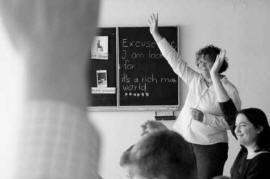Overview
English without Frontiers is a curriculum (method, syllabus and materials) to teach English as a Foreign Language to adult learners with intellectual disabilities or learning difficulties. The curriculum was developed by an international consortium as part of the Barrier-Free Language Learning project.
On this website you will find information about the target group, the methods and the materials. Also: information on how you can order the curriculum.
 The curriculum consists of a Teacher's Guide and materials.
The curriculum consists of a Teacher's Guide and materials.
In part I of the Teacher's Guide, you will find information about the theory, methods and materials of the curriculum (you can download Part I of the Teacher's Guide as a .pdf file, here).
In part II, you will find the actual curriculum: descriptions of activities for 10 units and the worksheets for these units.
On the accompanying DVD and CD-ROM you will find Part I and Part II of the Teacher's Guide, as well as additional materials:
- The worksheets for 10 units, in .pdf and PowerPoint format;
- Flashcards for 9 units, in .pdf and PowerPoint format;
- A special bilingual dictionary in .pdf and Word-format;
- Video clips of English speakers, for 10 units
- Interactive computer activities for 9 units.
Prior knowledge
Many activities require the learners to use their prior knowledge of the world, to help them understand English words and phrases. The world referred to in the stories and activities resembles as much as possible the (often limited) world that our target group has personal experience with.
Intellectual disabilities, learning difficulties 
Although the curriculum was developed specifically for adult learners with intellectual disabilities, the materials can probably be used effectively with learners of a wide range of (dis-)abilities.
The main characteristic of our target group is that they learn more slowly and with more difficulty than the average adult learner. Most of them do not learn ‘by exposure’ only. In comparison to mainstream curricula, the English without Frontiers curriculum uses very explicit instruction, very small steps, and frequent repetition.
A second characteristic of our target group is that they don’t easily generalise what they’ve learned in one situation to a new situation. Therefore, we made the materials resemble real life, as much as possible. In particular: the personal lives of our target group.
Language problems
In all activities, we use concrete, everyday language. All activities are demonstrated by the teacher. Most activities use multimedia stimuli: video, props, pictures, role play. Most activities include tips on how they can be adapted to meet the needs of non-speaking or non-reading participants.
Motivation

We have included useful language for participants who want to learn (some) English for a job, to communicate with people in other countries during holidays or exchange programmes, or who just want to learn some English, for fun. We have added fun activities to keep all learners motivated.
Beginners and ‘false’ beginners
The curriculum was developed to be appropriate for true beginners, but also for learners who already know some English because they have had some formal instruction, or because they have picked up some English informally, from television, songs, movies, etc. (so called ‘false’ beginners).
Age: 16-56
To make the course interesting for a considerable age range, we made sure that none of the materials could be considered childish, too young or too old, for any specific age-group. We included adult topics such as moving to a new house, working, going to a party, drinking beer. In the videos we used speakers of different ages; the main characters: Mike, Jill and Peter are in the middle range of our target group; in the pilot courses, adult learners varying between 16 and 56 years of age, found it easy to identify with them.
Teachers
During the pilot courses, the units were tested with a wide range of learners. The success of the course always depended on the teacher(s). With a target group as diverse and as varied as ours, a good, flexible and motivated teacher is indispensable and much more important than materials and worksheets. Even with a curriculum specifically developed for the target group, a good teachers is needed to bridge the gap between the materials and activities, and the needs and preferences of the learners.

